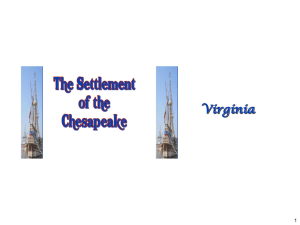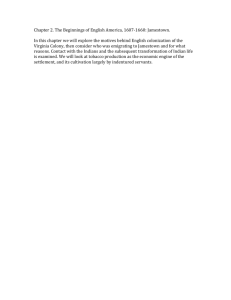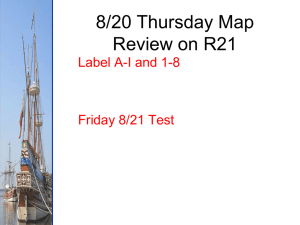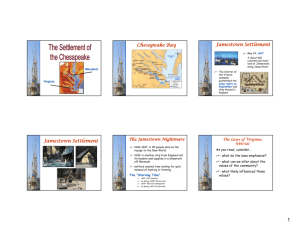Chesapeake Power Point
advertisement
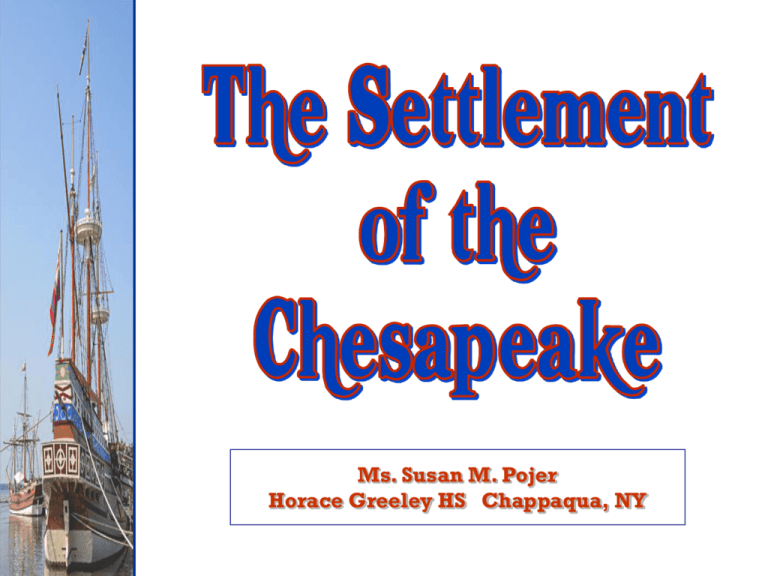
Ms. Susan M. Pojer Horace Greeley HS Chappaqua, NY Virginia English Colonization The Charter of the Virginia Company: Guaranteed to colonists the same rights as Englishmen as if they had stayed in England. This provision was incorporated into future colonists’ documents. Colonists felt that, even in the Americas, they had the rights of Englishmen! The Mercantilist Impulse: Mercantilism called for the state to regulate and protect industry and commerce. The primary objective was to enrich the nation by fostering a favorable balance of trade. Once the value of exports exceeded the cost of imports, gold and silver would flow into home ports. The whole concept was based on the notion that a nation’s power was based on its possession of gold and silver. Colonies would produce raw materials for the mother country and would enhance the self-sufficiency of the mother country. A thriving trade would lead to more taxes and customs duties that would fill royal coffers. James I lent his approval to a private venture a joint stock company known as the Virginia Company. England Plants the Jamestown “Seedling” Late 1606 VA Co. sends out 3 ships Spring 1607 land at mouth of Chesapeake Bay. Attacked by Indians and move on. May 24, 1607 about 100 colonists [all men] land at Jamestown, along banks of James River Easily defended, but swarming with disease-causing mosquitoes. Jamestown Settlement, 1609 Chesapeake Bay Geographic/environmental problems?? Jamestown Fort & Settlement Map Jamestown Fort & Settlement (Computer Generated) Jamestown Housing Jamestown Settlement Jamestown Chapel, 1611 Chief Powhatan Powhatan Confederacy Powhatan dominated a few dozen small tribes in the James River area when the English arrived. The English called all Indians in the area Powhatans. Powhatan probably saw the English as allies in his struggles to control other Indian tribes in the region. Powhatan Confederacy Powhatan Indian Village Indian Foods Smith’s Portrayal of Native Americans The Jamestown Nightmare 1606-1607 40 people died on the voyage to the New World. 1609 another ship from England lost its leaders and supplies in a shipwreck off Bermuda. Settlers died by the dozens! “Gentlemen” colonists would not work themselves. Game in forests & fish in river uncaught. Settlers wasted time looking for gold instead of hunting or farming. Captain John Smith: The Right Man for the Job?? There was no talk…but dig gold, wash gold, refine gold, load gold… Countrymen, the long experience of our late miseries I hope is sufficient to persuade everyone to a present correction of himself, And think not that either my pains nor the adventurers' purses will ever maintain you in idleness and sloth... ...the greater part must be more industrious, or starve... You must obey this now for a law, that he that will not work shall not eat (except by sickness he be disabled). For the labors of thirty or forty honest and industrious men shall not be consumed to maintain a hundred and fifty idle loiterers.[5]1609 Culture Clash in the Chesapeake Relations between Indians & settlers grew worse. General mistrust because of different cultures & languages. English raided Indian food supplies during the starving times. 1610-1614 First Anglo-Powhatan War De La Warr had orders to make war on the Indians. Raided villages, burned houses, took supplies, burned cornfields. High Mortality Rates The “Starving Time”: 1607: 104 colonists By spring, 1608: 38 survived 1609: 300 more immigrants By spring, 1610: 60 survived 1610 – 1624: 10,000 immigrants Pocahontas Pocahontas “saves” Captain John Smith A 1616 engraving Her marriage to Rolfe in 1614 led to a period of peace with the Indians. Pocahontas Pocahontas John Rolfe What finally made the colony prosperous?? Tobacco Plant Virginia’s gold and silver. -- John Rolfe, 1612 Early Colonial Tobacco 1618 — Virginia produces 20,000 pounds of tobacco. 1622 — Despite losing nearly one-third of its colonists in an Indian attack, Virginia produces 60,000 pounds of tobacco. 1627 — Virginia produces 500,000 pounds of tobacco. 1629 — Virginia produces 1,500,000 pounds of tobacco. English Migration: 1610-1660 River Settlement Pattern Large plantations [>100 acres]. Widely spread apart [>5 miles]. Social/Economic PROBLEMS??? Jamestown Colonization Pattern: 1620-1660 Reform and Boom in Tobacco Key reforms in 1618: 1) Company established the “headright system” to attract more settlers. New settlers received 50 acres and anyone who paid the passage of others to Virginia received 50 acres per head. 2) the Company abolished martial law and allowed the planters to elect a representative assembly -- the House of Burgesses. It first met in 1619, beginning the strong tradition of representative assemblies in theBritish colonies. 3) Immigrants flocked into the country. -Ordinary English working people -Young (15-24) and male; 3/4 came as indentured servants. Tobacco Prices: 1618-1710 Why did tobacco prices decline so precipitously? Indentured Servitude Headright System Indentured Servitude Headright System: Each Virginian got 50 acres for each person whose passage they paid. Indenture Contract: 5-7 years. Promised “freedom dues” [land, £] Forbidden to marry. 1610-1614: only 1 in 10 outlived their indentured contracts! Mortality Rates Remained High 1624 population: 1,200 despite more than 3500 immigrants in the years between 1619 and 1624 Adult life expectancy: 40 years Death of children before age 5: 80% “Widowarchy” High mortality among husbands and fathers left many women in the Chesapeake colonies with unusual autonomy and wealth! Richard Frethorne’s 1623 Letter In-Class Activity: Identify the FACTS presented in your section of the document. Be skepticalIs there any obvious bias/POV? What conclusions can you draw from the facts presented? • • Anticipate a problem/future issue? See any historical relationships between past events or future ones? Virginia: “Child of Tobacco” Example of a “monoculture.” Tobacco’s effect on Virginia’s economy: Vital role in putting VA on a firm economic footing. Ruinous to soil when continuously planted. Chained VA’s economy to a single crop. Tobacco promoted the use of the plantation system. Need for cheap, abundant labor. War with the Native Americans Why was 1619 a pivotal year for the Chesapeake settlement? The American Paradox: Freedom and Slavery Virginia House of Burgesses Growing Political Power The House of Burgesses established in 1619 & began to assume the role of the House of Commons in England “Power of the Purse”: Control over taxation and appropriation of funds. By the end of the 17c, H of B was able to initiate legislation. A Council appointed by royal governor Mainly leading planters. Functions like House of Lords. High death rates ensured rapid turnover of members. English Tobacco Label First Africans arrived in Jamestown in 1619. Their status was not clear perhaps slaves, perhaps indentured servants. Slavery not that important until the end of the 17c. Culture Clash in the Chesapeake 1614-1622 peace between Powhatans and the English. 1614 peace sealed by the marriage of Pocahontas to Englishman John Rolfe. 1622-1644 periodic attacks between Indians and settlers. 1622 Indians attacked the English, killing 347 [including John Rolfe]. Virginia Co. called for a “perpetual war” against the Native Americans. Raids reduced native population and drove them further westward. Powhatan Uprising of 1622 Results of the Massacre of 1622 1) Coordinated, sweeping attacks killed one-fifth of the white population. 2) Swift English retaliation wiped out whole tribes and cut down an entire generation of young Indian men. 3) News jolted English investors into determining the condition of the Virginia Company. The investigation revealed that a) Despite the tobacco boom, the Company was plunging toward bankruptcy. B) Over 3,000 immigrants had not survived the brutal conditions of the Chesapeake. 4) In 1624, King James I dissolved the Company and made the Virginia a royal colony. Culture Clash in the Chesapeake 1644-1646 Second Anglo-Powhatan War Last effort of natives to defeat English. Indians defeated again. Peace Treaty of 1646 Removed the Powhatans from their original land. Formally separated Indian and English settlement areas! Virginia Becomes a Royal Colony James I grew hostile to Virginia He distrusted the House of Burgesses which he called a seminary of sedition. The Commission report on the condition of indentured servants alarmed him. He hated tobacco. He was furious when he learned that officials of the Virginia Company had been involved in the seizure of a Spanish slave ship by two English vessels masquerading as Dutch, and the subsequent transportation of the Africans to Jamestown 1624 he revoked the charter of the bankrupt VA Company. Thus, VA became a royal colony, under the king’s direct control! Settling down in the Chesapeake, 1630s - 40s The tobacco boom broke and more settled social and political life emerged. The price of tobacco leveled off. Planters, who also dominated colonial politics and the House of Burgesses, were less likely to drive their servants to death. They raised more corn and cattle and mortality rates declined as food supplies rose. Freed servants who lived out indentures usually worked a few more years as hired hands or tenant farmers. Most managed to save enough to buy their own land. Settling down (cont.) For women who survived servitude, prospects were even better. With wives at a premium, they had good chances of improving their status by marriage. By 1650, Virginia could boast 15,000 inhabitants, although much of that resulted from servants and free immigrants. But Virginians looking to expand into more northerly bays of the Chesapeake found their way blocked by a new colony -- Maryland established in 1634 by Lord Baltimore as a haven for Catholics. Maryland The Settlement of Maryland A royal charter was granted to George Calvert, Lord Baltimore, in 1632. A proprietary colony created in 1634. A healthier location than Jamestown. Tobacco would be the main crop. His plan was to govern as an absentee proprietor in a feudal relationship. Huge tracts of land granted to his Catholic relatives. Colonization of Maryland St Mary’s City (1634) Currency in Early Maryland A Haven for Catholics Colonists only willing to come to MD if they received land. Colonists who did come received modest farms dispersed around the Chesapeake area. Catholic land barons surrounded by mostly Protestant small farmers. Conflict between barons and farmers led to Baltimore losing proprietary rights at the end of the 17c. In the late 1600s, black slaves began to be imported. A Haven for Catholics Baltimore permitted high degree of freedom of worship in order to prevent repeat of persecution of Catholics by Protestants. High number of Protestants threatened because of overwhelming rights given to Catholics. Toleration Act of 1649 Supported by the Catholics in MD. Guaranteed toleration to all CHRISTIANS. Decreed death to those who denied the divinity of Jesus [like Jews, atheists, etc.]. In one way, it was less tolerant than before the law was passed!! MD Toleration Act, 1649 The Toleration Act of 1649 ...whatsoever person or persons shall from henceforth upon any occasion of offence otherwise in a reproachfull manner or way declare call or denominate any person or persons whatsoever inhabiting, residing, traficking, trading or comercing within this province or within any ports, harbours, creeks or havens to the same belonging, an Heretick, Schismatick, Idolator, Puritan, Independent Presbyterian, Antenomian, Barrowist, Roundhead, Separatist, Popish Priest, Jesuit, Jesuited Papist, Lutheran, Calvenist, Anabaptist, Brownist or any other name or term in a reproachful manner relating to matters of Religion shall for every such offence foreit and lose the sum of ten shillings Sterling or the value thereof to be levied on the goods and chattels of every such offender and offenders... and if they could not pay, they were to be "publickly whipt and imprisoned without bail" until "he, she, or they shall satisfy the party so offended or grieved by such reproachful language...." Early Africans in the Chesapeake • • • • • A number of bound laborers, apprehended as they attempted to escape from their master's plantation, received the following sentences for their crime. The excerpt is from the legal records of early Virginia. From Decisions of the General Court, 1640, reprinted in The Virginia Magazine of History and Biography (Vol.5,1897.1898), 236-37. July 22nd, 1640. Whereas complaint has been made to this Board by Capt. William Pierce, Esqr., that six of his servants and a negro of Mr. Reginald’s has plotted to run away unto the Dutch plantation from their said masters, and did assay to put the same in Execution upon Saturday night, being the 8th day July, 1640, as appeared to the Board by the Examinations of Andrew Noxe, Richard Hill, Richard Cookeson and John Williams, and likewise by the confession of Christopher Miller, Peter Milcocke and Emanuel, the foresaid Negro, who had, at the foresaid time, taken the skiff of the said Capt. William Pierce, their master, and corn, powder and shot and guns to accomplish their said purposes, which said persons sailed down in the said skiff to Elizabeth river, where they were taken and brought back again, the court taking the same into consideration as a dangerous precedent for the future time (if left unpunished), did order that Christopher Miller, a dutchman (a prime agent in the business), should receive the punishment of whiping, and to have thirty stripes and so be burnt in the cheek with the letter R and to work with a shackle on his legg for one whole year and longer if said master shall see cause, and after his full time of service is Expired with his said master to serve the colony for seven whole years, and the said Peter Milcocke to receive thirty stripes and to be Burnt in the cheek with the letter R and after his term of service is Expired with his said master to serve the colony for three years, and the said Richard Cockson, after his full time Expired with his master, to serve the colony for two years and a half, and the said Richard Hill to remain upon his good behavior until the next offence, and the said Andrew Noxe to receive thirty stripes, and the said John Williams, a dutchman and a chirurgeon [surgeoni after his full time of service is Expired with his master, to serve the colony for seven years, and Emanuel, the Negro, to receive thirty stripes and to be burnt in the cheek with the letter R and to work in shackles one year or more as his master shall see cause.... 17c Population in the Chesapeake 100000 80000 60000 White 40000 Black 20000 0 1607 1630 1650 1670 1690 WHY this large increase in black popul.?? The Paradox begins “About the last of August came in a dutch man of warre that sold us twenty Negroes.” John Rolfe, 1619 • The Christian kingdom of Kongo @1619 • Mass in the Catholic kingdom of Kongo • John Pedro Crisis in the Chesapeake, 1660-1676 • Indentured Servants lived longer and became free, many obtaining land after working for a few years as freemen for a large landowner. They produced more tobacco. • Th increase in production of tobacco by Marylanders and more Virginians led to the falling price of tobacco. • Gentry gobbled up the remaining good land in the lower areas and so newly freed servants had to go West in order to obtain land. This brought them into conflict with Indians. • The increased costs on inter-coastal trade associated with the Navigation Acts helped added to the crisis. • The House of Burgesses tried to extend the indentures of servants and ruled that if people lost their land, they could no longer vote. Frustrated Freemen Late 1600s large numbers of young, poor, discontented men in the Chesapeake area. Little access to land or women for marriage. 1670 The Virginia Assembly disenfranchised most landless men! Nathaniel Bacon’s Rebellion: 1676 Led 1,000 Virginians in a rebellion against Governor Berkeley Nathaniel Bacon Governor William Berkeley Rebels resented Berkeley’s close relations with Indians. Berkeley monopolized the fur trade with the Indians in the area. Berkley refused to retaliate for Indian attacks on frontier settlements. Bacon’s Rebellion: 1676 Bacon’s Rebellion Rebels attacked Indians, whether they were friendly or not to whites. Governor Berkeley driven from Jamestown. Bacon’s forces burned the capital. Rebels went on a rampage of plundering. Bacon suddenly died of dysentery. Berkeley brutally crushed the rebellion and hanged 20 rebels. Governor Berkeley’s “Fault Line” Results of Bacon’s Rebellion It exposed resentments between inland frontiersmen and landless former servants against gentry on coastal plantations. Socio-economic class : small planters, tenants, and servants vs. the gentryelite. Upper class planters searched for laborers less likely to rebel BLACK SLAVES filled the bill!! The Atlantic Slave Trade The “Middle Passage” Colonial Slavery As the number of slaves increased, white colonists reacted to put down perceived racial threat. Slavery transformed from economic to economic and racial institution. Early 1600s differences between slave and servant were unclear. By the beginning of the 18th century, black slaves outnumbered white indentured servants. Colonial Slavery Beginning in 1662 “Slave Codes” Made blacks [and their children] property, or chattel for life of white masters. In some colonies, it was a crime to teach a slave to read or write. Conversion to Christianity did not qualify the slave for freedom.

